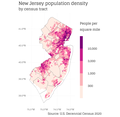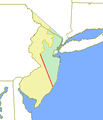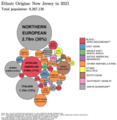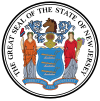Portal:New Jersey
The New Jersey Portal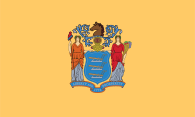 New Jersey is a state situated within both the Mid-Atlantic and Northeastern regions of the United States. It is the most densely populated of all 50 U.S. states, and is situated at the center of the Northeast megalopolis. New Jersey is bordered on its north and east by New York state; on its east, southeast, and south by the Atlantic Ocean; on its west by the Delaware River and Pennsylvania; and on its southwest by Delaware Bay and Delaware. At 7,354 square miles (19,050 km2), New Jersey is the fifth-smallest state in land area, but with close to 9.3 million residents as of the 2020 United States census, its highest decennial count ever, it ranks 11th in population. The state capital is Trenton, and the state's most populous city is Newark. New Jersey is the only U.S. state in which every county is deemed urban by the U.S. Census Bureau with 13 counties included in the New York metropolitan area, seven counties in the Philadelphia metropolitan area, and Warren County part of the heavily industrialized Lehigh Valley metropolitan area. New Jersey was first inhabited by Paleo-Indians as early as 13,000 B.C.E., with the Lenape being the dominant Indigenous group when Europeans arrived in the early 17th century. Dutch and Swedish colonists founded the first European settlements in the state, with the British later seizing control of the region and establishing the Province of New Jersey, named after the largest of the Channel Islands. The colony's fertile lands and relative religious tolerance drew a large and diverse population. New Jersey was among the Thirteen Colonies that supported the American Revolution, hosting several pivotal battles and military commands in the American Revolutionary War. On December 18, 1787, New Jersey became the third state to ratify the United States Constitution, which granted it admission to the Union, and it was the first state to ratify the U.S. Bill of Rights on November 20, 1789. (Full article...) Selected article -
Carlton Hill Station was a former railroad station for the Erie Railroad in the community of Rutherford, New Jersey, United States. Carlton Hill station was the second station along the Erie's main line and the first station after Rutherford Junction, where the Erie's main line forked from the Bergen County Railroad. The station provided service for passengers in Rutherford's Carlton Hill district and freight billing for the Royce Chemical Company. After Carlton Hill, the main line continued westward to Passaic Park and eastward to Rutherford–East Rutherford and Pavonia Terminal.
Carlton Hill Station opened in 1888 on Jackson Avenue and namesake Erie Avenue in Rutherford. The station was served by the main line until 1963, when the Passaic Plan was undertaken, removing tracks at Passaic Park, Passaic, Clifton, and Lake View stations. At that point, the nearby drawbridge was permanently swung open and later removed, leaving a branch to Carlton Hill. For the next few years, Carlton Hill received deadhead trains and a rare Carlton Hill – Rutherford – Hoboken Terminal train schedule. In 1966, when several underused branches, including the Carlton Hill, lost service, the old main line alignment to Carlton Hill was abandoned. The tracks remain, though the building is gone. Selected picture - Credit: KForce The Hackensack River is a river, approximately 45 miles (72 km) long, emptying into Newark Bay, a back chamber of the New York Harbor. The watershed of the river includes part of the suburban area outside New York City; it is separated from the Hudson River by the New Jersey Palisades. New Jersey news'Related portalsSelected biography -George Thomas Reynolds (May 27, 1917 – April 19, 2005) was an American physicist best known for his accomplishments in particle physics, biophysics and environmental science. Reynolds received his PhD in physics from Princeton in 1943, writing a thesis of the propagation of shock waves. During World War II, he joined the United States Navy, and served with the Manhattan Project. He worked with George Kistiakowsky on the design of the explosive lenses required by the implosion-type nuclear weapon. He was involved in the investigation of the Port Chicago disaster, served with Project Alberta on Tinian, and was part of the Manhattan Project team sent to Hiroshima and Nagasaki to inspect the bomb damage. (Full article...)Did you know? -
General imagesThe following are images from various New Jersey-related articles on Wikipedia.
TopicsQuality content
CategoriesThings you can do
For more information on how you can help, see the WikiProject New Jersey. Associated WikimediaThe following Wikimedia Foundation sister projects provide more on this subject:
Discover Wikipedia using portals |














